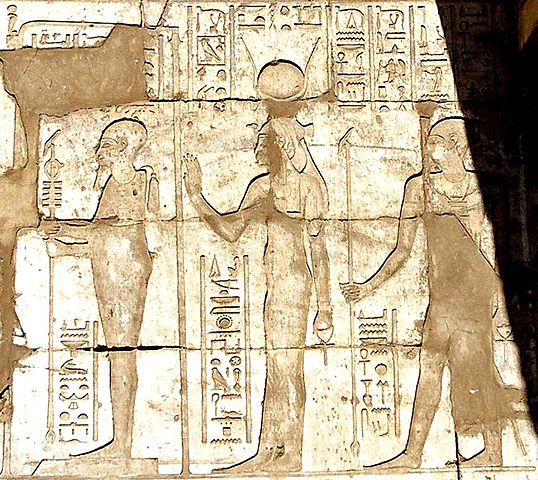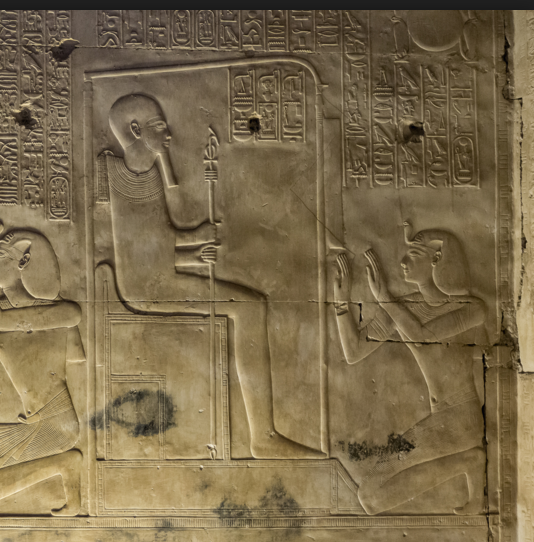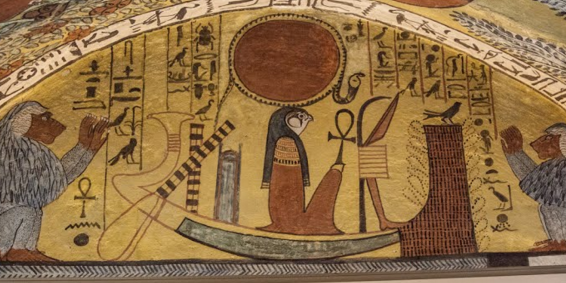rituals
Part II – the Oscars, Ptah’ and the shrine at the root
PART II
Above, Pteh’ to the left; and right in front of him is the short line –
“(by) he/every kind of (thing)/below,/(through) the foreign land’s double-place-T
to become new by the root/thou/existence/to give;”
where “the foreign land’s place-T to become new” is “the land of Punt”,
a mythological land supposedly being somewhere south-east of egypt —
but in reality the land upon the eden-tile
[usually termed Geb in the spells];
Seti I tomb,
above (and for larger version see link below),
this time he is seated upon the SHEPS-throne, upon the same strange tile;
the three small columns in the top-rightcorner within the shrine read,
“all (of)/place-T of the q-axis (to beat),/
thou/existence/(as) existence/to give,/to recite; /
(cartouche-name)/the torso for the an-face,/to recite; /
place-T to sacrifice/(by) all (of)/Pteh’/(for) existence of hail,/to recite;”
…the “sacrifice” obviously addressing the eden-tile,
the few columns above the head of the kneeling Seti –
“(cartouche-name)/the royal south (suten)/
the double cord of double willpower/(for) the an-face/
(as) the cord/thou/the essence to pour-out of praise,/
(by) to make to give (by Cain-soul)/the Utcha eye,/
(through) to become the root of hail/by/(lost)/I am;/
Horus/thou/existence/(by) thou/eye, /
Horus/thou/eye/thou/existence to bring (ánn);
(through) existence (eden’s)/to come hail\\(for)
the advanced beautified-soul (canaanite spirit 2.0),/
(by) the land (south, eden)/the speech/(for) me/to guard,/
all/evil words of place-T of the mountain /
to force the speech (unusual)/to become the word of hail,/
(by) this (pn)/branch (matrix)/
(the great door) to open (eden),/(for) the speech/
to become by place-T of the m-b-soul-adam for
willpower (matrix)/(by) to come to make to un-tie
(eden; via ad.soul)/to become the praised/
willpower (matrix)/(unreadable)/(cartouche-name);”
– rest unreadable from picture
| Ramesses III tomb, to right; where Pteh’ stands within the strange formed shrine, in which corner is the short line, “the divine house as place-T of the eden-cherub/\\(as) place-T of the foremost kh-house/(of) Pteh'”; and like the previous Lourdes fragment, the first glyph being too close to NNIU as cherub to can ignore, proven by the magically-dangerous double-slash\\; and a cut-off line in front of the shrine, the first part of the line not visible because of the photo’s border, “…… Pteh’/(by) he place-T of hail/(for) existence (matrix)/the lights of speech to connect to existence/(as) the god,/(by) place-T to give;”, where the ‘he’ in “he place-T for hail” is eden’s; we will return to this mural shortly, |
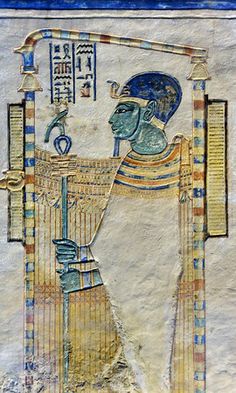 |
Nefertari tomb,
Above, mural from the tomb of queen ‘Nefertari’,
the same type shrine, and within it a few columns,
reading from right to left, starting down –
“place-T of great speech/(by) he/
(-T of) the adamite throne/the dome/the an-face/(of) beauty,/
(double-bar-glyph)/the royal south (suten)/
(as) place-T of justice/(by) all (of)/Pteh'”;
the double-bar meaning is not clear;
it could be a compressed “two lands” without det.,
but also the glyphs existence-existence;
– five menkh realm-garments:
In the opening of the mouth pages we saw how the scribe
mentioned ‘5 garments’ (as opposed to the dictionary which
mentions six bandages); in this mural stand upon the table
in front of the shrine five garments, as well,
and right above them three short columns,
reading from left to right –
“to sanctify/the land (south, eden)/by/place-T of justice/
(for) all (of)/existence/(through) place-T of
the menkh garment-realm/(as) place-T of willpower of speech;”
– four pillars (?):
the queen of Ramesses holds up a tablet with standing upon it
four props/pillars; they are likely not intended as garments
since the cloth-glyph is lacking inbetween them, and in the
text written in front of her (which is from left to right,
but probably the first part is not showing),
“to become the great pillar/
the god,/(by means of) the West’s/(double-) place-T of the foremost/
(in order for) Osiris’ (as construct)/speech and nature,/
(as) the word of the true voice/(name of queen),/
(for) all (of)/the dimension/place-T of dimensional width/
(fór) the two lands (south)/(through) place-T of all/
(namely) place-T of great speech/(for) to make a goddess;”
the lines do not address the four props directly,
yet the context suggests the main place-T related to
‘the four of the hand of he’; the “two lands” is the term
for “the land (eden’s)”, when théirs; and here, the
“foremost” is the nose-glyph, as “foremost-adam”,
so the ‘II’ may be a magically-dangerous double-slash here,
and instead can read “..the West, by\\place-T of the foremost-adam…”;
and the last glyph could be “H’EMST” as “place-T to dwell”,
but it appears that S-H’EMT was intended,
with “woman, queen” as H’EMT, since shé is the woman here;
(all separate writers have their own peculiarities;
we could only learn them by reading all within the tomb),
– curiousity:
a short look-around tells us that she repeats the same line
in many murals, and also here they show – in front of her,
above her, and as she herself sitting in the house
(probably playing Senet); this mural isn’t Pteh’-related,
but us struck the bizarre likeness of her with the Ba-bird,
positioned behind her – clearly inténded to resemble the queen,
as in some alter-ego; indicating that her inner being has
changed into a Ba spirit-soul; note how the bird stands
upon a fortress, like Anubis lays upon it in an amtuat-hour –
we will come to that fortress, shortly;
– the name ‘Nefertari’:
in several murals showing the cartouche with her name,
it is written in a different order,
but MUT- is sure, as also MER-T, and NEFER+Á+T+R,
NEFERÁTER\\ MUT N MERT is the likely version;
in spoken language contextually as
“the beloved of existence as the mother\\ of speech of beauty”,
yet that line having a range of other possible colours.

Ramesses I tomb,
above; here, the shrine is absent;
the two columns on both sides of the djed-pillar read,
“the eden-light (within) saturn’s eternity,/
forever/(as) the light (eden)/(for) hail/alike-adam (miá), /(by) he/
the dimensional background of Saturn (h’a),/(through) all (of)/the uas sceptre, /
the djed-pillar/(for?) the ãnkh-life/(of) protection (Sa);”,
we still investigate the concept UAS and TCHET’,
so we can’t know yet who causes what,
inbetween Ramesses and Pteh’, next to the staff,
“the light (eden)/(for) hail/alike-adam (miá),/(by) he (eden-light)/
(for) existence (matrix)/speech to make (ár-r)/
(through) the four cherub\\wheels/(as,for?) the (t’ua-) star as the god;”—–
the glyphs are crystal-clear:
it is almost impossible that “four lights” are intended
(and even then it would contextually fall back to the cherubs, anyway;
neither it can be HRU-light because the latter is composed
out of six type lights); while the “star+axe” can be little else
as t’ua-star;
there are two lines written above Ramesses and Pteh’,
they are intended as a dialogue (!): the line Ramses tells,
reads (from down-left until first cartouche),
“the place of the double djed-pillar/(of?)
the torso for the an-face/(by?) the double-place-T of the West/
(as) all (for)/to become the great pillar/the god,/(in order for)
the divine Osiris (as construct)/(of) the hail/(as) the true voice/
(of) Rã-mess-śu’s/(khu-) spirit;”,
….the line ends there, just above the lefthand-side cartouche,
and a second line starts above Pteh’, up until the second cartouche
(read from the right to centre),
“the two lands (south)/(by) to make/the sky of earth (north)/
all/to become (by) the great pillar/(as) the god,/
(for) great speech (matrix)/(by) he/(-T of) the adamite throne/
(for) the dome of the an-face/(of) beauty;/
(in order for) the two lands/(as) the royal south (suten)/
(of) willpower/(by) place-T to sacrifice/(as) place-T of all/
(of) Pteh’,/to make the name of Rã-men-peh’ (cartouche-name)/
(for) Osiris (as construct);”,
….the cartouche’s name as RÃ MANPEH’ alike
“the dimensional backside of Eden’s root as the stability for Rã”;
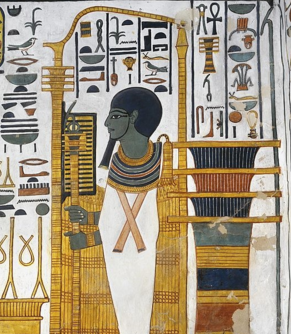 |
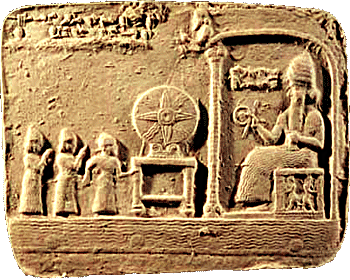 |
4] the shrine
why the strange form?
we can only observe that the top of the right pole
looks like a sekhem-sceptre, while the top of the left pole
incorporates the djed-pillar; but we do not know why
to his right stands a separate djed-pillar
(though the Ramesses mural showed a ‘double djed pillar’);
the strange curved roof appears as if some
‘illegal connection’ is made between both;
compare this scene with the sumerian tablet, to right;
even the ‘table’ in front shows,
together with the same type bent pole.
The sumerian deity is seated, which Pteh’ does as well
(in the Seti mural, above); and the two figurines
below his seat are either the two dwarf-humanoids
he created [glyph BES], or adamite souls;
the “sun” upon the table is more tricky –
we assumed before that it is “mutilated eden light”
as the glyph HRU-, yet this Nefertari mural shows
the MENKH-realm-garments, which are álso “types of light”,
but we will need to study this particular theme more,
– then there is the strange ‘box’ to his left,
in front of his face,
| tomb of Sennedjem, this was a great find! For the first time, it shows clearly the bent pole to the right, as glyph SHEMS-; the main boat atop the horizontal line is depicted (see diagrams), and in front of Horus is the Shems-symbol. This glyph, to right, shows the same ‘rectangular box’ which is in front of Pteh’, and officially has two protruding diagonal knives (as depicted in amtuat VI, where the ennead is represented by them); but here strange as having the lower diagonal not as knife but as ‘foot’; we suggest that the knives are “illegally bound tó the pole”, implying the pole with curve atop is eden’s; but eventhough in both murals this construction is “in front of the deity”, the construct is shown flipped, concerning the official meaning of Shems-, “to follow”, the glyph appearing many times throughout all spells, but as “adamite soul/to wander-astray”, which would make the context “the gods (matrix)/(by the construct of) the adamite soul/wandering-astray”; the glyph-pic to right would not read ‘follower of Thoth’, but as |
 |
[ intermezzo II – searching the pole in glyphs]
 |
So we started looking how the core of the glyph appears, and *if* the pole with half-curve is originally Eden’s, it should show – the NN- is the cherub-glyph, to right, though here doubled (but why?), morphed into the saturn-phallus h’eNN, later into h’enn; |
| the same shape returns in the glyph TER-, ‘season’, to right; an often used matrix term for “speech/(by) place-T”; but often ending on Á- or I-, which is important because the “hail Á- by” indicates it is an eden concept; note, how the pole “stands upon a small R-glyph (as mouth)”, which is the same position as the Pteh’-shrine stands upon; and, by extension, the small “bulb” halfway the centre of the pole could be this main-place-T, itself? being at the same spot as the “rectangular box” in front of Pteh’..? | 
|
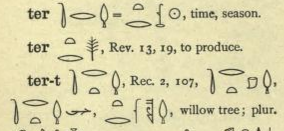 |
The same term in “willow tree”, above; note how the halfstaff-T is used here, “the tree/(as) place-T/(for) speech/(by) halfstaff-T”, (often in spells as THERT, “to connect to”), this willow tree is found in several places in scripture, as here in the book of Isaiah, “and·they-sprout in·between grass as·oleanders on runnels-of waters” And they shall spring up [as] among the grass, as willows by the water courses and the willow is immediately related to ‘watercourses’, read, related to speech; |
| the glyph TER- turning into P-TER, to right, not as ‘what is it’, but “place-T/(of) the adamite soul/(as) the passive pole/\\ (for) place-T/(of) the root (matrix)”, the figurine holding his chin as ‘passive’, and the magically-dangerous double-slash \\ makes it almost sure that the pole itself is eden’s, |
 |
| the glyph extending into P-TERÁ, with as root the ‘season’, TERÁ, but now from the matrix-root; “the serpent/(of) sight/(by) the pole/(of) hail,/(for) speech/(by) place-T/(of) the matrix root”, though the colour of the line may vary somewhat; the “double-eye” shown may either be “double sight” or “two eyes” – we don’t know that, yet; |
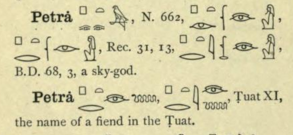 |
 |
the glyph RENP- as either “youth” or “year”, the glyph above shows the double pole (compare the double cherub-pole NN, above); followed by a magically-dangerous, then RENPT, “the double pole/\\ (for) place-T/(of) the root (matrix)/(for) existence of speech (matrix)”, |
| the REN-, “name”, as crucial concept linked to the RENNUTT cobra, to right; please note again the double cherub pole NN-, indicating their speech *is* by this double pole, “the cobra/(as) the doubled place-T/(of) the word/(by) the cherub pole/(for) speech (matrix)”; the eden-NN morphing into matrix-nn, just as we saw by the phallus h’eNN-; the cobra steals the ‘names’ of the adamite originals fróm the cherub poles, as ‘harvest’, or factually steals the speech óf the adamite soul, then transfers this “existence of speech” to their new root, as REN-P; glyphs in the REN-cluster are “babe, youth, heifer, cartouche-name, to nurse”, etc, RENFRETH, ‘a god in amtuat II’, – as “to connect to/speech/(for) he/the existence of speech (matrix)”, (we skip another similar pole as the RES-, ‘south’, for now), |
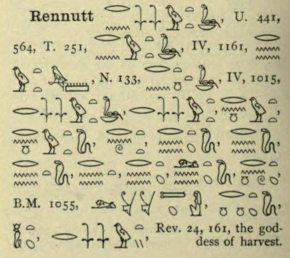 |
|
In amtuat VIII return the same type Shems poles, |
 |

